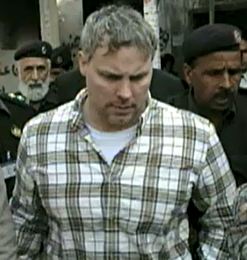
Raymond Davis on the day of his arrest. (screengrab from YouTube http://www.youtube.com/watch?v=x-kcRDhatoM)
Raymond Davis is to make a second appearance in a Colorado courtroom today, as prosecutors have upgraded the assault charge against him from misdemeanor to felony level. The charge arises from an argument and fight over a parking space at a suburban Denver bagel shop on Saturday morning. While the descriptions that have emerged of the fight suggest that it is appropriate for Davis to face this charge, the appearance of Davis in a criminal proceeding raises a larger question. Back when Davis was still in Pakistani custody, one of the arguments presented by the US in trying to obtain his release was that Davis would face investigation and potential prosecution for the killing of two Pakistanis once he was back in the US. Davis was released March 16, but no reports of him facing even an investigation, let alone charges, from the killings in Pakistan have emerged.
The Los Angeles Times has details on the Saturday fight:
The fight was reported Saturday outside Einstein Bros. Bagels in Highlands Ranch. Authorities have released few details about the fight and did not identify the other person involved, and a Douglas County sheriff’s spokesman did not return calls or email late Monday.
But KUSA-TV in Denver reported that Jeff Maes was the man allegedly assaulted by Davis. Maes told KUSA-TV that the fight began over a parking space in the crowded lot about 9 a.m.
“Instead of going by and saying, ‘Hey that was my spot,’ he goes behind me, rolls his window down and starts cussing me out,” Maes said.
He added that the altercation quickly escalated as his wife and two young daughters watched.
“I said, ‘You need to relax,’ ” Maes said. “I said, ‘This is stupid,’ I turned, and he hit me.”
Just one month before Davis was released, Senator John Kerry traveled to Pakistan to lobby high level Pakistani government figures for Davis’ release. One of the enticements Kerry offered was that Davis would face investigation for killing the two Pakistanis in Lahore once he returned to the US:
The Guardian described Kerry’s efforts:
Senator John Kerry, the former US presidential candidate, is holding high-level meetings in Pakistan in an attempt to defuse a diplomatic crisis involving a US embassy worker who shot dead two Pakistanis last month.
Kerry has scheduled talks with the prime minister, Yousuf Raza Gilani, and the head of the army, General Ashfaq Parvez Kayani, over the case of Raymond Davis, which has pushed anti-American sentiment in Pakistan to fever pitch.
The article then gives Kerry’s assurance that Davis would face investigation in the US:
Ahead of today’s discussions, Kerry expressed regret over the deaths and promised that Davis would face a US criminal investigation if he were to be released by the Pakistani government.
“It is customary in an incident like this for our government to conduct a criminal investigation. That is our law. And I can give you the full assurance of our government today that that will take place,” Kerry told reporters in the eastern city of Lahore. “So there is no such thing as a suggestion that something is out of law or that America thinks somehow we’re not subject to the law.”
It would appear that Kerry was just blowing smoke and that at least when it comes to Davis killing two people in Pakistan, Davis was indeed “not subject to the law”. At the very least, if the investigation Kerry promised is ongoing, it is being conducted in utter secrecy. However, it appears that Davis is not above the law when it comes to the local authorities in suburban Denver.
Kill two people in a foreign country, stirring up massive anti-American protests in the process, and the government will spare no expense in freeing you with no further consequences, but punch a man over a parking space in an Einstein Brothers parking lot and face the full fury of the law. Ain’t justice in the US grand?